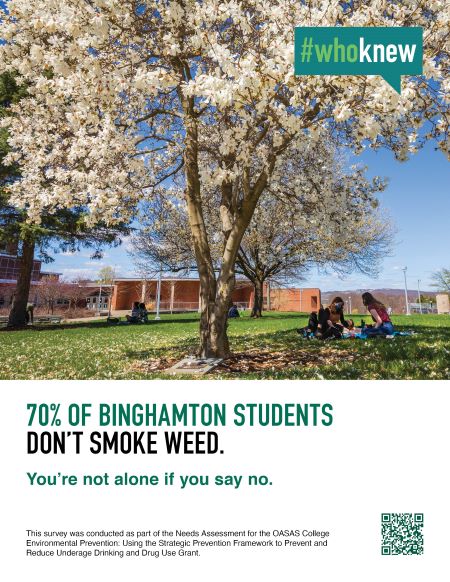
“70 percent of Binghamton students don’t smoke weed.”
This is one of many statistics regarding alcohol and drug usage among students that have been seen on flyers around the Binghamton University campus since 2019.
The data is often received as a surprise by students, as the flyers aim to combat false perceptions of social norms. The flyers were created as part of the University’s #WhoKnew campaign, an initiative launched in 2019 to reduce underage drinking and drug use. In 2017, BU, along with 19 other SUNY and CUNY schools, had received a five-year grant from the New York State Office of Alcoholism and Substance Abuse Services (OASAS), allowing them to pursue the initiative.
As part of the grant, schools distributed a survey on substance usage, created through SUNY and OASAS, to students in 2017, 2019 and 2021. The University had also used the grant to establish the Binghamton Campus and Community Coalition, a group of local stakeholders that work to reduce substance misuse.
In 2019, BU had partnered with a marketing agency, Idea Kraft, to launch a “social norms” campaign with its survey results. Linda Reynolds, the college prevention coordinator of the Alcohol, Tobacco and Other Drugs (ATOD) program, said the campaign provides particular benefits in reducing substance use among younger adults.
“Research has indicated that college students tend to overestimate peer substance use and, in turn, this misperception influences individual attitudes and behaviors,” Reynolds wrote in an email. “The goal with a social norms campaign is to correct misperceptions by providing accurate information.”
According to Reynolds, the 2021 survey had used a stratified random sampling method based on year and gender involving 6,999 undergraduate students at BU. Students had been sent the anonymous survey via email, and were also entered into a drawing for a $500 gift card after participating.
Among the questions asked in the fall 2021 survey were questions asking respondents to state the number of days they had smoked weed or used pain medications without a prescription within the past 30 days. Other questions asked students how often they ate before or after alcohol consumption and how often they alternated alcoholic and nonalcoholic drinks.
In the flyers posted around campus regarding student usage of marijuana and prescription pain products, the 30-day stipulation was not included. Anton Schick, a professor of mathematics with a research focus in statistics, suggested the omission of this information was made out of practicality.
“It is important to ask the right question,” Schick wrote in an email. “Maybe the assumption that drug users typically do not quit was made to come to this conclusion. Of course, some students may have experienced drugs in the past, but may no longer be using them.”
According to Schick, a stratified random sampling method was an appropriate approach to the survey, though he said potential issues may arise with respondents not being truthful.
Still, the campaign has sparked conversations among students. One student, Dimitri Gouvoussis, a junior majoring in biomedical engineering, said he had remembered seeing the flyers in dining halls as a freshman. While Gouvoussis said he doubted the truthfulness of the respondents, he said a survey that was not anonymous would likely pose additional challenges.
In regard to the questions asked in the fall 2021 survey, Gouvoussis suggested more frequent drug users would have difficulty remembering their usage in the past 30 days.
“If you were to say marijuana, I would know the answer to that because the answer is zero, but if you were to say something else, no,” Gouvoussis said. “Also, I don’t think I’d be willing to take the effort to recall all the times I did said substance either, especially if there’s no incentive for accuracy.”
Other students, like Thomas Bravata, a junior majoring in psychology, said the data was accurate in regard to their own usage. Bravata said he was still surprised by the information displayed in the posters, though it had caused him to consider the broader issue of drug use on campus.
“The posters kind of help try and show that drug use isn’t as rampant as it might seem to be when you are in certain scenarios like parties and if you want to, say, not give into peer pressure or refuse a certain substance you’re not alone,” Bravata said. “It sort of helps put things into perspective that this sort of party culture isn’t as common as is often stereotyped.”
According to Reynolds, the University has seen some decline in underage drinking since the OASAS grant was provided in 2017, though the effects of the campaign are difficult to gauge. In addition to the social norms campaign, the ATOD office also provides various other initiatives to combat underage drug and alcohol use, including workshops and trainings for students.
As the #WhoKnew campaign continues to promote discourse, Reynolds said the conversations fostered are just one of many ways to reduce substance usage on campus.
“Anecdotally, I do have students regularly come up to me and ask where the data came from, so that indicates to me that the campaign is spurring conversations,” Reynolds wrote. “That’s exactly what we want the social norms campaign to do. The hope is that the campaign challenges students to consider if maybe their perception of what is going on is just reflective of what the media portrays or the immediate handful of friends they surround themselves with, and not actually reflective of the larger campus population. ”


